Table of Contents
Literary work gives a clear and detailed meaning to fictional, non-fictional, and poetry work. An epigraph is a quotation that is placed at the beginning of any literary work, which provides readers with the opportunity to enter a world full of disruption. An epigraph definition is something new to students, and this might be the reason why they often wonder—what is the epigraph? Are you also one of those who is not clear about this term and wonders what it could be? With this blog post from AllAssignmentHelp, find an answer to all your questions related to epigraphs in literature.
What is an Epigraph – Epigraph Definition
The term ‘epigraph’ is derived from the Greek word “epigraphein,” which means “to write on. It refers to an important phrase or word in literature that provides depth and context to a piece of writing. The epigraph definition stands for something that can either be a quotation or poem that is often placed at the beginning of a document. the epigraphs used in different forms of writing. A few of the common writings are novels, poetry collections, essays, and academic papers, which provide a deeper and better understanding of concepts.
The epigraphic sentences are used in fictional quotations, literature, and films. We hope that the epigraph definition is now clear to you. Moreover, if you are a student of literature, you should understand this term in detail to effectively use it in sentences. Whenever you find yourself stuck at learning and need help with your online course, just pay for online class help from professional writers.
Different Uses of Epigraph
Epigraphs are a powerful tool that is used in different types of literary works. A few of the written works where this term is used are listed below.
1- Epigraphs in Classic Novels
Epigraphs are actively used in novels. It helps to improve the reader’s experience by providing insight, context, or thematic resonance at the beginning of the story. The Great Gatsby by F. Scott Fitzgerald, Kill a Mockingbird by Harper Lee, and Frankenstein by Mary Shelley are a few of the popular novels where epigraphic sentences are actively used.
2- Epigraph in an Essay
Essays are one of the common forms of assignments assigned to students studying English or related courses. Do you know that epigraphs are also used in essays? Yes, it is used to provide a good context for the discussion. Furthermore, different factors need to be considered to effectively use an epigraph in an English essay. If you are not aware of these factors, hire professional experts and let them handle all your work. Just search for someone who can take my online English class for me, and they will complete all your online classes, including your essays, on time.
3- Epigraph in a Book
Epigraphs are commonly used in different books. The main reason why they are used in books is that they help set the tone, and thematic context, or offer insight into the author’s intentions.
The epigraphism of sentences is a versatile literary device that is used in various types of written works, not only the ones listed above. They are also used in chapters, poetry collections, plays and screenplays, short stories, memoirs and biographies, articles, and reports.
Epigraph vs. Epigram Differences
Epigrams and epigraphs are the two terms that people think hold similar meanings but have different literary terms. Do you also get confused with these literary terms and their purpose and often wonder, Can I pay someone to take my online class for me? Well, it is normal for students to seek online class help when they fail to understand difficult concepts. But you need not have to worry, as we have got to help you. We have tried to clear the confusion between epigrams and epigraphs.
- An epigraph is a short quotation or saying at the beginning of a book, while an epigram is a brief, witty, and often paradoxical statement.
- Epigraphs establish the mood or atmosphere for the work, and epigrams deliver a humorous or satirical message.
- Epigraphs are placed at the beginning of a book, chapter, essay, or other section, and on the other hand, epigrams can appear anywhere in a text.
- Epigrams are used in poetry, essays, and social commentary, and epigraphs can be used also in films, books, literature, and short stories.
- Epigrams are single sentences or short poems and do not require attribution, while epigraphs are quotation marks and attributed to the original author.
- Epigrams can be used to criticize or praise, while epigraphs do not do this.
These are some of the common differences between two similar-looking terms, epigraphs and epigrams. Moreover, if you do not understand literary devices and need any assistance, seek English literature homework help and let professionals provide personalized homework in English as per your requirements.
Why Use Epigraph in Academic Writing?
We have so far discussed a few of the important factors of epigraphs. But do you know why epigraphs are important and used in English literature work? If not, refer below to find an answer to your questions.

- It helps to set the tone: Setting the right tone is an important part of any literature, and epigraphs rightly do this work. It aligns everything and sets the emotional tone for readers right from the start, which will make them stay engaged over time.
- It provides context to the discussion: The main purpose of an epigraph is that it offers background information or a philosophical framework. It further helps readers clearly understand the given text.
- It highlights themes: It highlights the theme of the novels, poems, and essays and creates a sense of anticipation.
- It helps relate to other popular works: An epigraph can establish a dialogue between the current work and other literary works, which will in turn improve the reader’s experience and help them understand the author’s work.
- Epigraphs engage readers: The main reason why authors use epigraphs in their novels or poems is because it deepens the reader’s experience with new words. The usage of popular quotes at the beginning of the sentence captures the reader’s attention right away and makes them engaged.
- Adds in-depth meaning: Epigraphs are a kind of quotation or phrase that adds a layer of interpretative richness to the sentence, which further clears the narrative to the reader.
Now the usage of epigraphs might be clear to your right. Furthermore, if you are a student of English, it is possible to receive multiple English assignments back to back. rather than stressing, seek essay writing help and start submitting professional essay writing even on difficult topics timely.
How to Select the Right Epigraph
An epigraph definition is something that helps to set the tone and provide context to the sentence. However, selecting an appropriate epigraph is essential and requires careful consideration. A few tips to select the right epigraphs for a sentence are listed down below.
- Impactful: The main reason an epigraph is used in a written work is that it resonates with readers and leaves a lasting impression. So make sure to choose one that can have some impact on the readers.
- Original: There are a few common epigraphs that are used almost everywhere to improve the effectiveness of work. However, using new quotes can offer a unique perspective.
- Credible: If you are someone who is using epigraphs for the first time in their work, make sure to use credible quotes so that you can further enhance the credibility of your own work.
- Tone: We know that epigraphs help in setting the tone of the literary work. However, you can blindly use any epigraph in your work. Make sure to check whether the tone of the epigraphs is merging with your work or not. If not, do not use it as it can break the flow.
- Connection: The best epigraph is the one that can easily be connected to the content of your work.
Epigraphs are impactful quotes and a powerful tool that can make your work look more effective. However, make sure to use the right paragraphs for your work so that the readers will be able to see the link between the quote and your writing.
Also Read: Ways to Proofread the Errors in the Sentences
Popular Epigraph Examples
There are different renowned examples of epigraphs that are used in different written works. Some of the popular epigraph examples are listed down below.
- Then wear the gold hat, if that will move her
- If you can bounce high, Bounce for her too
- Lawyers, I suppose, were children once
- Did I request thee, Maker, from my clay
- To mold me, Man, did I solicit thee
- From darkness to promote me?
- Till she cry ‘Lover, gold-hatted, high-bouncing lover
- I must have you
- Sixty Million and more
- You are all a lost generation
- One generation passeth away, and another generation cometh
- And when Rachel saw that she bare Jacob no children
- All animals are equal, but some are more equal than others
- Behind every exquisite thing that existed, there was something tragic
- Till she cries, ‘Lover, gold-hatted, high-bouncing lover
- Ego non baptizo te in nomine patris, sed in nomine diaboli
- The cattle are lowing, the baby awakes. But the little Lord Jesus, no crying He makes
- Never again will a single story be told as though it were the only one
- If they give you ruled paper, write the other way
- You are saved!
- But as to myself, having been wearied out for many years with offering vain
- In the desert there is no sign that says, Thou shalt not eat stones
These are a few well-known epigraphs from various literary works. This component functions as a vital tool that can quickly and effectively communicate critical information to readers. It further helps in improving their comprehension and engagement with the story.
Also Read: All About Writing a Poetry Analysis Essay-Tips and Guide
Frequently Asked Questions
| Question 1: How to format an epigraph? Placement, indentation, attribution, font, style, and quotation marks are a few of the important formatting elements that help in effectively sharing thematic similarities of the author’s work. |
| Question 2: What are the creative uses of epigraphs in modern writing? Epigraphs have also taken their place in modern writing and not just in traditional writing. Modern writers are innovatively using it in song lyrics, films, television, and poetry collections. |
| Question 3: How to write an effective epigraph? There is no hard-and-fast rule of how to write an effective epigraph or how to use epigraphs in effective writing. However, a few things, like understanding the purpose, choosing relevant content, keeping it concise, and ensuring relevance and resonance, are a few things that would help you in doing so. |
| Question 4: What is an epigraph in literature? An epigraph in literature is a small phrase or quote that provides introduction or context to the readers. |
| Question 5: What are some of the epigraphs examples? The Great Gatsby by F. Scott Fitzgerald, To Kill a Mockingbird by Harper Lee, and Frankenstein by Mary Shelley are some of the popular examples of epigraphs in literary writing. |
